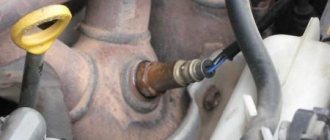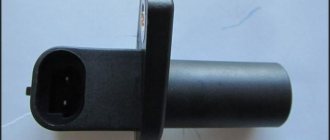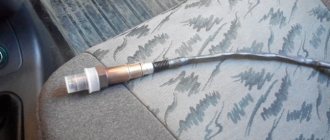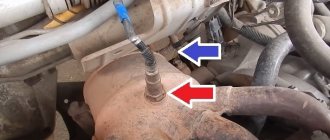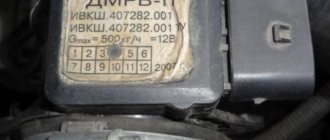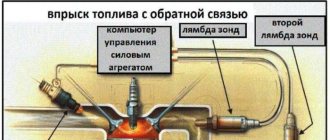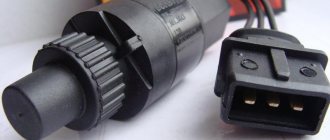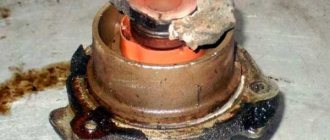Location and service life of the controller
On a VAZ-2112 with engines with 16 valves, the measuring device is located at the exhaust pipe, between the exhaust manifold and the coupling.
To replace the device, you must gain access to the underbody of the vehicle body. For the best convenience, you need to drive the car into a garage with a pit or drive onto an overpass located near the highway. The service life of the oxygen sensor may vary. If a motorist uses a high-quality fuel mixture, the service life will be up to 110 thousand kilometers. In the case when a low-quality mixture is used, the service life is reduced to 85 thousand kilometers.
The cheapest way to replace a lambda probe on a VAZ 2112 is to do it yourself
The lambda probe for the VAZ 2112 is located on the exhaust pipe of the exhaust manifold
VAZ 2112 lambda sensor (or oxygen sensor) is located in the exhaust manifold of the engine. Its readings enable the control unit to adjust the desired ratio of air to gasoline that enters the combustion chambers. And in the case when a lean or, on the contrary, very rich fuel mixture arrives, the electronic unit adjusts its composition, taking into account the readings given by the lambda probe on the VAZ 2112.
How to determine that the DC is faulty
The first signs of a lambda probe malfunction or how to check an oxygen sensor
Motorists often ask what symptoms of a malfunction a faulty oxygen sensor may have. Here are the most common of them:
- Unstable starting of a cold and hot engine.
- Errors appeared on the dashboard. Signs of DC malfunction are failures P0137 and P0578. They also often occur when the DTOZH malfunctions, so a check is needed.
- There is too much fuel consumption at short distances.
- Ignition of the working mixture in the cylinders.
- Exhaust gases that are black or bluish-black are also signs of a DC malfunction. This may also indicate a poor quality fuel mixture.
- The engine begins to "trouble". Extraneous sounds are observed. Which indicates that the driver has been using a low-quality fuel mixture for a long time.
conclusions
There are few signs of a malfunction of the oxygen sensor on the 16-valve VAZ-2112 engines, and in order to be completely sure that the oxygen sensor is not working, you need to connect to the computer and look for errors. There is only one method for troubleshooting - replacing the sensor. You can do this yourself, since there is nothing complicated in the process.
A lambda probe (upper oxygen sensor) installed before the catalyst monitors the oxygen content in the exhaust gases. According to its readings, the engine ECU sees whether the fuel mixture in the engine is now rich or lean, thereby adjusting it to the optimal one. It is under these conditions that the best combustion of the fuel mixture occurs. Moreover, under these conditions an optimal ratio of engine power and fuel consumption is achieved.
Euro-3 standard and more.
Description of the oxygen sensor
DMRV sensor VAZ-2112 16 valves signs of malfunction: check
Let's start with a description of the device. We invite you to familiarize yourself with its purpose, structure, and operating principle.
Purpose and location
The VAZ 2110 lambda probe largely influences the stable functioning of the engine, ensuring the normal operation of its parameters. This controller is an electronic device used to determine the amount of oxygen present in the exhaust gases. This is necessary in order to reduce the volume of harmful impurities and elements contained in exhaust gases. In order to ensure the required proportion of the air-fuel mixture, which affects the reduction in the concentration of impurities, air must be supplied to the engine in the required quantity.
Lambda probe installation location
This is not always achieved, and the reasons may be different. If the controller fails, the carbon monoxide content in the exhaust gases will be about 3-7%, while the standard value is 0.3%. As for the location, this sensor on a VAZ is installed on the exhaust pipe of the muffler, from below. The readings recorded by the lambda probe are transmitted to the motor control unit. And the ECU, focusing on them, adjusts the composition of the combustible mixture, thus setting the required time for the injection phase.
Design and principle of operation
The VAZ 2110 oxygen sensor consists of the following elements:
- steel body;
- insulator component, which is made from ceramics;
- O-ring with wiring and cuffs;
- a special case with holes for ventilation;
- ceramic tip;
- conductive contact;
- a special shield, which also has holes through which gases are released;
- filament coil.
The device is based on two electrodes - internal and external, the first is made of zirconium, and the second is made of platinum. The zirconium electrode is in direct contact with the exhaust gases, and the platinum electrode is in contact with the air. The values that the controller receives are based on the potential difference between these elements. To ensure optimal operation of the oxygen controller, the device must be heated to 300-400 degrees (video author - MotorState channel).
The temperature is quite high, it is achieved through the use of a special heating component, which is built into the structure of the lambda probe. When the engine starts, the control unit adjusts the composition of the combustible mixture based on the readings of other controllers, and not just the lambda probe. In particular, we are talking about mass air flow sensor, throttle opening sensor, antifreeze temperature in the system, etc. And the control unit begins to refer to the lambda probe readings only after the device has warmed up to operating temperature.
Kinds
The first “Ten” injection engines used standard oxygen controllers from the manufacturer Bosch. In 2004, when these car models began to be equipped with more modern injection systems, which were called January 7.2, Bosch M7.9.7, the cars began to be equipped with modernized versions of VAZ oxygen regulators. The latest version differs from the earlier one in that it is equipped with a ceramic heating element, thanks to which less electricity consumption is achieved.
But even this allowed the controller to warm up faster. Currently, Bosch produces seven different types of oxygen sensors with different powers - 12 and 18 W. It should be noted that these devices differ from each other, perhaps, in the values of energy consumption and the number of contacts. In all other respects they are identical.
Device and symptoms of malfunction
To completely burn 1 kilogram of fuel mixture, about 14.7 kilograms of air are needed. Therefore, the lambda probe data is very important in the fuel supply system, since its performance directly affects the smooth and stable operation of your car’s engine. Periodic checking of its performance is very important, however, before checking the lambda probe, we need to study the device, as well as the principle of operation. The oxygen concentration meter sensor, otherwise called a lambda probe, (in our case the VAZ 2112 lambda probe) includes the following elements:
- Metal body with threads for mounting
- Sealing ring
- Ceramic insulator
- Electrical signal current collector
- Wires
- Cuff that seals wires
- Live contact for heating circuit
- Protective shell (outer) with ventilation hole
- Ceramic tip
- A special tank with an incandescent coil in it
- Protective screen, with a hole for the passage of exhaust gases
All parts of the lambda probe are made of materials resistant to high temperatures, since the sensor itself has a fairly high operating temperature, so it is not afraid of overheating, while overheating, for example, a motor will have dire consequences (and this is possible if the probe faulty). Probe sensors can have from one to four wires in the device, respectively, the name comes from them: one and so on up to four wire sensors. By the way, some “craftsmen” claim that the VAZ 2112 works well without a lambda probe, but they are mistaken, it’s just that until the engine is warmed up, the readings of the sensor are not taken into account during injection, since it has not reached its operating temperature, therefore, you can trust such advice drive without it, only on a cold engine. Breakdown of the oxygen sensor is often caused by violations in the maintenance and care of internal engine parts and some other factors, such as:
- Cleaning the body (washing) with products that are not intended for this purpose
- Accidental contact with coolant or brake fluid on its body
- Increased content of lead (metal additives) in fuel
- Severe overheating (red hot) of the sensor housing, which is caused by an unrefined combustible mixture
- In addition, the ingress of highly contaminated gasoline may occur due to a malfunction of the gasoline pressure regulator, or the DTOZh (coolant) temperature sensor, or a clogged fuel filter.
As a rule, if the lambda probe of the VAZ 21124 is faulty, this causes the following very noticeable problems in the operation of the engine:
- Its need for fuel increases, its consumption increases
- The car jerks when driving
- Unstable motor operation occurs
- The operation of the catalyst is disrupted
- Exhausts exceed permissible toxicity standards
Lambda probe replacement kit
In the photo above we see what a replacement probe looks like, which is worth purchasing to replace it yourself.
Checking the probe status
So that you can check the performance of your oxygen sensor with your own hands, you will need the following items:
- Operating instructions for your car, which will tell you where the lambda probe is located in the car
- Digital voltmeter
- Oscilloscope
We have listed only the basic necessary auxiliary tools. The engine will need to be warmed up during the test. Now we’ll tell you how to check the lambda probe on a VAZ 21124 yourself, it’s simple:
- Do a lean test. To do this, you need to take a vacuum tube and provoke an air leak. When your oxygen sensor is working properly, then the voltmeter readings are about 0.2 Volts or lower
Oxygen sensor for VAZ 2112
Signs of a faulty crankshaft sensor on a diesel engine
The oxygen sensor (hereinafter referred to as OS) is designed to measure the amount of oxygen in the exhaust gases of a car for the purpose of subsequent adjustment of the enrichment of the fuel mixture.
A rich and lean mixture is equally “bad” for a car engine. The engine “loses” power, fuel consumption increases, and the unit operates unstable at idle.
Domestic car brands, VAZ and Lada, among others, have one oxygen sensor preinstalled. European and American technical means are equipped with two controllers:
- Diagnostic;
- Managers.
They are no different from each other in design and size, but perform different functions.
The oxygen sensor is located in the exhaust manifold
Before moving directly to identifying the signs, you need to know where it is located and what it is responsible for. A lambda probe is a car sensor that reads the amount of oxygen released from the exhaust gases and regulates the supply of the fuel mixture.
Often, car manufacturers choose the location in front of the catalyst. In this case, the sensor is located in the exhaust manifold. Some automotive critics believe that this location is not entirely correct, since the probe should be located directly in front of the catalyst.
Layout of the oxygen sensor in the exhaust system
Also, to refine the system, oxygen sensors with feedback can be installed and used. To do this, another lambda probe is installed after the catalyst, which is connected to the electronic control unit. This was done in order to more accurately read data from exhaust gases, regulate the fuel mixture and reduce fuel consumption.
Replacement and can it be turned off?
Replacing the oxygen sensor is quite simple, since it only requires disconnecting it from the power supply and unscrewing it from the exhaust manifold. But with the question of whether it is possible to drive with the sensor disabled, everything is much more complicated.
Diagram of the location of the oxygen sensor with feedback
Symptoms and error codes
So, let's look at the main symptoms of a faulty oxygen sensor on a 16-valve VAZ-2112 engine:
- Increased fuel consumption.
- Failure at idle.
- Decrease in engine dynamics and power.
Design features of the oxygen sensor
It is worth noting that other sensors have the same reasons, so to get a more detailed answer, you need to connect to the engine’s electronic control unit and see exactly what errors popped up.
So, let's look at what errors are caused by a faulty lambda probe:
| Error P0130 | Invalid oxygen sensor signal 1 |
| Error P0131 | Low signal level of oxygen sensor 1 |
| Error P0132 | Crankshaft sensor 1 signal high |
| Error P0133 | Slow response of oxygen sensor 1 |
| Error P0134 | No signal from oxygen sensor 1 |
| Error P0135 | Oxygen sensor 1 heater malfunction |
| Error P0136 | Oxygen sensor 2 short to ground |
| Error P0137 | Low signal level of oxygen sensor 2 |
| Error P0138 | Oxygen sensor 2 signal high |
| Error P0140 | Oxygen sensor 2 break |
| Error P0141 | Oxygen sensor 2 heater malfunction |
| Error P1102 | Oxygen Sensor Heater Resistance Low |
| Error P1115 | Faulty oxygen sensor heating circuit |
Reasons for reducing the service life of equipment
- A natural factor due to the duration of operation without intermediate prevention;
- Mechanical damage;
- Manufacturing defect;
- Loose contact on the end switches;
- Unstable operation of the firmware of the electronic control unit as a result of which the input data is interpreted incorrectly.
Crankshaft position sensor VAZ 2110
The crankshaft position sensor of the VAZ 2110 injector is quite important, since without it the engine cannot be started. Any malfunction of it brings the “tens” ECU or “brains” of the engine into a stupor. The sensor monitors the position of the camshaft (and therefore the pistons in the cylinders) in real time and allows the spark plugs to work in time. The spark plugs receive a signal from the ignition module that the upper compression point in the cylinder has reached and it’s time to “light” the spark. The sensor itself looks schematically as in this figure -
This is a small electromagnet that picks up the position of a toothed pulley that rotates nearby. The pulley has 58 teeth, which create electromagnetic disturbances. Actually for an injection engine, this is the main and most important sensor.
Types of sensors
All probes are completely identical in principle of operation. All the differences lie in the features of the power supply connection. In practice, they are usually distinguished by the number of wires that are connected to the probe. The most common are two- and three-pin sensors. There are also options with and without heating. Heated sensors are more effective when starting the engine in winter, they show better results.
If necessary, both types of probes are interchangeable. You can also install a sensor from any car, even with a different number of wires. Only in this case will you have to tinker with the connection.
How to check a lambda probe
It is best to diagnose the lambda probe using specialized equipment at a service center. This is the only way to accurately determine its malfunction, as well as find out the reasons why it failed.
Only rough diagnostics can be carried out at home. And a regular multimeter turned on in voltmeter mode will help you do it. Before checking the oxygen sensor, you will need to warm up the car engine to operating temperature. Next, you need to turn off the motor and disconnect the probe connector. We connect the signal wire of the sensor to the positive probe of the multimeter. We connect the negative contact of the device to the ground of the car. We start the engine, load it to 2500 rpm and look at the instrument readings. If the voltage value is close to 0.9 V, the VAZ lambda probe is working and the cause should be looked for elsewhere. But if the voltmeter readings are below 0.8 V, most likely the sensor has failed.
Functionality check
Many VAZ-2112 owners ask how to check the lambda probe (oxygen sensor) themselves. To do this you will need to do the following:
- It is necessary to turn off the engine and allow it to cool.
- After this, open the hood of the car and disconnect all contacts leading to the oxygen sensor.
- Take a multimeter and connect the end probes to the lambda probe.
- Then use the “Resistance” mode on the multimeter. If the arrow goes to infinity, then the device is working correctly and the readings are being transmitted correctly.
- In a situation where the arrow shows a value near zero, the measuring device is faulty and needs to be replaced.
How to extend the service life of a recreation center
To extend the service life of the sensor, you will need to follow the following recommendations:
- Conduct a technical inspection of the vehicle on time;
- use only original spare parts for the car;
- do not allow the use of low-quality fuel mixture;
- Contact a car service if you find problems with engine operation.
You can change the oxygen sensor on a VAZ-2112 yourself without going to a car service center. Only original components must be used. If there are problems starting the engine, you should check the correct operation of the lambda probe.
Recommendations for care and maintenance of the VAZ 2112 car
- During the period of the factory warranty, comply with the technical inspection deadlines;
- Buy parts with original catalog numbers. The full list of indices is specified in the VAZ 2112 operating manual;
- If a malfunction or unstable operation of the mechanisms is detected, contact a service station for comprehensive diagnostics;
- After the expiration of the factory warranty, carry out a technical inspection of the car at intervals of 15,000 km.
–> VAZ Masters / Electrical wiring and electrical equipment / Sensors
The lambda probe for the VAZ 2112 is located on the exhaust pipe of the exhaust manifold
Use a gas burner or stove
In this case, we will need a gas stove or burner and the already known phosphoric acid.
POPULAR WITH READERS: How to properly install a child car seat, selection criteria
The device is lowered into the acid for a few seconds and quickly brought to the fire.
Be careful not to expose any plastic covers that may be on the device to high temperatures.
After a certain time (you won’t have to wait long), a light gray salt will appear on the surface of the sensor core as the acid boils.
The acid should completely boil away. Do not allow vapors of the chemical compound to enter your respiratory system.
Remove the lambda probe from the fire, and then repeat the procedure again until the salt no longer appears.
Is it possible to drive without this sensor?
In fact, in most cases, the car can be operated if the lambda probe fails; only on some models, if the lambda probe fails, it will be impossible to start the engine. Here another question arises, how effective and useful this will be. The first sign of failure is increased fuel consumption. This is due to the incorrect reaction of the control unit to the current situation. Also, usually the car starts to become “stupid”; this is also a consequence of problems with the probe (see the article “Why does the car become dull when accelerating”).
Instrument testing
For such work, you can use a tester, oscilloscope or digital voltmeter. Considering the features of these devices, a voltmeter would be the optimal solution.
Examination
The check sequence will be as follows:
- Start the engine and let the car warm up.
- Next, we find the element we are interested in. If there are soot deposits or other external signs of a malfunction, there is no point in carrying out further testing with instruments. And so it is clear that it is out of order and needs to be replaced.
- Also check the condition of the wiring, the presence or absence of mechanical damage on the device.
- If everything looks fine, unplug the connector and connect a voltmeter.
- Now you can start the engine.
- Press the gas pedal in neutral to reach the 2500 rpm mark. After this, release the pedal.
- Remove the vacuum tube from the fuel pressure regulator.
- We check the oxygen sensor for functionality. To do this, look at what the voltmeter shows. If the reading is 0.8 volts or less, the probe is not working.
- It would be a good idea to check the device for a lean mixture. To do this, you need to turn on the air intake using a vacuum tube.
- If the voltmeter reads 0.2 W or less, the oxygen sensor is working normally. Deviation from these indicators indicates a breakdown of the device. Therefore, it needs to be replaced.
Article on the topic: Engine oil volume on a VAZ 2109
Diagnostics
It should be noted that checking the functionality of the lambda probe should be carried out in conjunction with vehicle maintenance, at intervals of every 10 thousand kilometers. However, if the car was operated in unfavorable climatic conditions, which is applicable to Moscow, or in aggressive mode, maintenance should be carried out more often. This is the manufacturer's recommendation.
The manufacturer also does not recommend performing independent diagnostics or repairs if there are signs of any malfunction. To fix it, you should contact a service center.
Diagnosis by visual inspection
The beginning of any diagnosis begins with a visual examination. Primary methods for diagnosing an oxygen sensor include:
- visual inspection of the electrical wiring of the lambda probe for integrity and absence of mechanical damage or rupture;
- inspection of the lambda probe itself. There should be no soot or hard deposits on its surface.
Carbon deposits on the oxygen sensor housing indicate a faulty electric heater or an excessively rich combustible mixture entering the combustion chambers.
Solid deposits on the sensor body indicate poor fuel quality and the presence of harmful impurities in it, or an incorrect proportion of the combustible mixture.
If there are no visible causes of the malfunction, more detailed diagnostics are performed.
Detailed diagnostics
At the service center, by connecting a diagnostic computer, all electronic systems of the car are checked. If one of them malfunctions, the on-board computer detects the error and stores it in its error register. Each error has its own code, which makes it easy to find out the source of the problem.
In the absence of a diagnostic computer, plumbing diagnostics are required, which involves partial disassembly and diagnostics with a voltmeter. It consists of the following operations:
- starting the engine and warming up to operating temperature;
- engine stop;
- disconnecting the sensor connector and connecting a voltmeter to it;
- restarting the internal combustion engine and one-time increase in idle speed to 2500 thousand per minute;
- disconnecting the vacuum pipe from the fuel pressure regulator;
- checking the voltmeter readings. If the reading is equal to or less than 0.8 V, the 2110 oxygen sensor is faulty. It cannot be repaired, therefore, replacement is necessary;
- checking the oxygen sensor to detect a lean fuel mixture. In this case, the air supply to the engine is artificially cut off. If the voltmeter reading is 0.2 V or less, the sensor is working. Other readings indicate a sensor malfunction.
Also in the service center, using a voltmeter, it is possible to check the signal supplied to the lambda probe from the electronic control unit. If the supplied voltage is higher than 0.45 V, more detailed diagnostics of the control unit is necessary.
Speed sensor VAZ 2110
The VAZ 2110 injector speed sensor is installed on the gearbox, more precisely on the speedometer output shaft. If the sensor is faulty this can cause the car to stall at idle in some cases. When the spirometer needle begins to move abnormally (intermittently) on the instrument panel, this should alert you. After all, this may indicate a malfunction of the speed sensor. The sensor itself looks like this, look at the photo.
The principle of operation of the “tens” speed sensor is based on the Hall effect; when the gearbox shaft rotates, the sensor transmits a pulse signal. The higher the rotation speed, the higher the frequency of the pulse signal. This is how the speed of the car is measured. Two types of sensors were installed on the VAZ-2110, one has a square connecting block, the other has a round one.
Repair
Diagnostics
The VAZ 2110 lambda probe has four outputs:
Pads for VAZ 21102
Checking the oxygen sensor heater comes down to a basic check of the heater circuit:
In the future, we are exclusively interested in the signal wire, or rather, the change in voltage passing along it from the sensor to the ECU during various engine operating modes. You can check the operation of the sensor in two ways:
- Using a voltmeter;
- Using an oscilloscope (motor tester).
Since this instruction is intended for the common man who simply cannot have professional equipment in principle, we will diagnose the sensor using a voltmeter.
Method one: reading trouble codes
In order to read the fault codes located in the controller’s memory, it is necessary to either connect special diagnostic equipment to the diagnostic block (located on the left side under the instrument panel console) (too simple - not for us), or close contact “B” to ground, which is so The same can be done by connecting contacts “A” and “B”.
Diagnostic block VAZ 2110
- “A” - contact connected to the vehicle ground;
- “B”—controller signal contact;
- “G” — control of the VAZ fuel pump;
- “M” is a contact for issuing information (serial data).
After these contacts are closed, turn the ignition key to position “III” (do not start the engine), observe the “CHECK” indicator, which should flash the number 12:
- Flash;
- 1-2 second pause;
- Flash;
- Flash;
- Long pause of 2-3 seconds;
- Double repetition of the above cycle.
Reading fault code number “12”
Attention! This code indicates that the self-diagnosis program is running, otherwise this program does not work.
After this, the program displays codes of existing faults in a triple cycle (each code three times), in the absence of these, code “12” continues to be displayed constantly.
Attention! When the diagnosis is completed, these contacts are allowed to be opened only after the ignition is turned off, after ten seconds.
Erasing fault codes from the ECU memory in order to make sure that the fault has been eliminated occurs by turning off the controller's power for at least ten seconds. The power is turned off either by disconnecting the negative terminal from the battery or by removing the controller fuse.
If you continue to drive with a faulty lambda probe
Briefly:
• Reduced compression in the cylinders, increased wear of compression rings and cylinders and, as a result, a reduction in engine life. Failure of spark plugs.
• Guaranteed failure of the catalyst and the 2nd lambda probe if you continue to drive with a faulty 1st lambda probe.
• Deterioration of cold engine starts, uncomfortable driving, accompanied by reduced power and floating idle speed and sometimes dips at speed from 2000 to 3000.
• Increased fuel consumption, on average by 5-20% of normal and even up to 50% in severe cases, which ultimately will result in the cost of a new lambda probe over the course of a year.
• A check engine light that simply adds worry to your life and behind which you can see another problem.
More details:
If any malfunction of a modern car appears, it is necessary to hasten to eliminate it, preferably refusing further intensive use until it is eliminated. This applies to lambda probes more than to any other parts. As is already known from the article “What is a lambda probe for?”, this sensor, together with the catalyst, is responsible not only for cleaning exhaust gases from harmful impurities, but also for the correct mixture formation in the combustion chambers. It sounds quite innocent, and many car enthusiasts believe that after the oxygen sensor fails, all that threatens them is an increase in harmful impurities in the exhaust system. However, this is not the case.
Let's try to figure out what happens to the engine and its systems when you continue to operate a car with a faulty oxygen sensor, using the example of two main threats.
Reducing engine life. Let us briefly describe the mechanism of this process, which develops in two directions.
As a result of a malfunction of the sensor or its incorrect operation under the influence of external factors, an over-enriched fuel mixture may be supplied to the cylinders. This mixture does not burn completely, as a result of which the electrodes and insulators of the spark plugs and combustion chambers become covered with black soot. Heavy carbon deposits coke the cylinder compression rings. An incomplete fit and a decrease in compression occurs, as a result of which some of the gases enter the crankcase and “poison” the oil.
But this is not as dangerous as the process that runs parallel to the one described above. The remains of unburned fuel that has penetrated the compression rings wash away the oil film from the surface of the cylinder, causing dry friction, leading to a reduction in its service life, and in advanced cases, to overheating of the engine.
Failure of the catalyst and the 2nd lambda probe. As we have already found out, exhaust gases with remaining fuel enter the exhaust pipe. As a result, the catalyst begins to work in emergency mode, burning out the remaining fuel. Gradually the catalyst is destroyed, the products of its destruction begin to clog its honeycombs. The catalyst begins to overheat and melts, finally sealing its entire honeycomb structure. As a result, the engine power finally drops and the car stops driving due to the fact that there is no room for free exhaust gases. During this process, the 2nd lambda probe is also poisoned.
Another important reason why you should quickly replace the oxygen sensor is the need to turn off the illuminated Check Engine light, since behind an error in the lambda probe, you can overlook the appearance of another error
Signs and causes of lambda probe malfunction
Lambda probe malfunctions manifest themselves in the same way as problems with fuel equipment or catalytic converter. Therefore, it is possible to determine exactly which element is broken only through diagnostics at a car service center. There are a number of symptoms that indirectly indicate that the lambda is failing:
- Floating speed when idling the internal combustion engine. If the lambda probe breaks down, they constantly change, dropping to 400-600. This happens due to a lean fuel mixture. It is not enough for stable operation of the engine in idling mode. The lambda probe is responsible for dosing fuel into the mixture.
- Decrease in engine power. A lean mixture reduces the power of the internal combustion engine. Its speed will begin to slowly increase when the accelerator pedal is pressed, the car will drive worse uphill, acceleration will become slower.
- Increased fuel consumption. Fuel consumption may increase by 25-30%.
- Change in color and odor of exhaust gases. The exhaust will turn black. It will clearly smell of gasoline that does not burn out in the catalyst.
- Candle color. If the mixture is over-enriched, they will develop a black coating.
- Uneven acceleration with jerks. The car will not be able to accelerate quickly and evenly.
- "Check Engine" indicator on the dashboard. If you consider the error as a scanner and decipher it, it will be clearly indicated that the lambda probe is broken. If the error is simply erased, it will constantly appear until the problem is eliminated.
Popular brands: Ford Focus, Toyota Corolla
Typical causes of failure are:
- Use of low quality fuel. This is perhaps the most common reason. Excess harmful impurities, when burned, settle on the working surface of the heating element, which leads to its clogging.
- Natural wear and tear over time. The lambda needs to be changed closer to 150 thousand kilometers. The period can be increased if high-quality fuel is used. A non-original or cheap sensor will last less.
- Wiring problems. To connect the lambda to the ECU, ordinary copper wire is used, which will later begin to oxidize or break.
Restoring the performance of the lambda probe by cleaning
In some cases, the oxygen sensor stops working only because the holes in the protective screen and the ceramic tip itself are covered with soot. To restore the functionality of the part, it is necessary to clean the soot from the lubricating zone, but when performing such work, you must follow certain rules
It is important not to use for cleaning:
- metal brushes;
- sandpaper;
- files;
- other objects that can damage the ceramic element.
The best method to get rid of contaminants is to soak the ceramics of the lambda probe in a solution of orthophosphoric acid, but to do this, you must first carefully saw off the protective cap. If acid cannot be found, you can use a rust converter, which is sold in stores selling auto chemicals. Of course, to clean the part from soot deposits, the sensor must be removed.
To soak a ceramic tip, it must be placed in liquid for 15-20 minutes; the soot should disappear from the surface on its own. If the deposits are not completely removed, they can be cleaned with a soft toothbrush. After the procedure, you need to secure the protective screen using camp welding. When it is not possible to restore the lambda's functionality, there is only one option left - to buy a new oxygen sensor.
The cheapest way to replace a lambda probe on a VAZ 2112 is to do it yourself
The lambda probe for the VAZ 2112 is located on the exhaust pipe of the exhaust manifold
VAZ 2112 lambda sensor (or oxygen sensor) is located in the exhaust manifold of the engine. Its readings enable the control unit to adjust the desired ratio of air to gasoline that enters the combustion chambers. And in the case when a lean or, on the contrary, very rich fuel mixture arrives, the electronic unit adjusts its composition, taking into account the readings given by the lambda probe on the VAZ 2112.
How to repair a lambda probe
Repairing a lambda probe with your own hands is quite simple; to do this, you need to determine in which particular unit the failure occurred.
If the problem is related to the circuit contacts, then first of all you need to find the break point and check whether the contacts have oxidized. The signal may simply not come from the control unit. Therefore, check the lambda power supply. If the element contacts have oxidized, they must be treated with WD40.
We recommend: Which is better, electric corrector or hydrocorrector for headlights on a VAZ 2110: pros and cons
If a lot of carbon deposits have formed on the probe body, it may be necessary to clean all parts of the system. And here a natural question arises: how to rinse the lambda probe. The fact is that it is strictly prohibited to process platinum electrodes and ceramic rods with sandpaper. Therefore, it is necessary to use specialized products designed to dissolve rust.
To clean the sensor, follow these steps:
- Remove the lambda probe after heating its housing to 50 degrees.
- Remove the protective cap.
- Soak the sensor in phosphoric acid for 30 minutes (it will cope with even the most difficult deposits).
- Rinse the lambda in water, dry it and install the element back. Don't forget to lubricate the sensor threads with a special agent to create a complete seal (but don't use silicone sealant).
Since the cost of sensors ranges from 1000 - 3000 rubles per element, it is quite reasonable to try to repair the lambda probe yourself (see video below), and only then proceed to install a new element.
Why does P0134 occur?
There are not so many reasons that can lead to error P0134. It specifically indicates an incorrect signal being received from a particular sensor. Based on this, we can conclude that the causes of error P0134 are as follows:
Diagnostic equipment makes it easier to determine the cause of a problem. If, in addition to error P0134, the diagnostic tool reports the presence of error P0171, this indicates that the malfunction is associated with an open or short circuit. As you know, error P0171 indicates a lean mixture in the engine. It occurs together with error P0134 with the above-mentioned malfunctions, since the first oxygen sensor in the exhaust circuit is the control one for supplying the mixture. Accordingly, if it stops transmitting information, the electronic control unit will reduce the amount of fuel supplied, causing the air-fuel mixture to be lean - this is necessary to prevent possible breakdown of the catalyst.
It is worth noting that most often the P0134 problem is directly related to the failure of the sensor itself. In no more than 5% of cases, a malfunction occurs due to a short circuit, open circuit or oxidation of contacts.
How does it work
The principle of operation of a lambda probe is to compare the indicators of two electrodes, one of which is located in clean air, and the second in the exhaust manifold.
The VAZ 2110 lambda probe is made of heat-resistant materials, since the exhaust valve system and exhaust system have extremely high temperatures during prolonged engine operation.
The main structural elements of the lambda probe are:
- steel body;
- external platinum electrode;
- internal zirconium electrode;
- ceramic insulator between the inner and outer electrodes;
- electric heater;
- protective casing for the outer electrode.
Also, lambda probes, with some technical differences, have a 4-pin connector:
- 1 contact - signal transmission to the electronic control unit;
- 2 - electrical power;
- 3 and 4 - electrical power supply to the electric heater.
The main task of the lambda probe is to determine the amount of unburned oxygen in the exhaust pipe.
The electronic control unit supplies the electrodes of the lambda probe with a voltage of 0.45 V.
The outer electrode determines the amount of ambient oxygen, the inner electrode determines the amount of oxygen in the exhaust gases. Having received the data, the sensor transmits the corresponding signal to the electronic control unit of the internal combustion engine. The transmitted signal is the difference between two indicators.
The control unit, having processed the received signal, makes adjustments to the operation of all components of the fuel system, and also ignites the combustible mixture earlier or later. This contributes to more stable and smooth engine operation.
On VAZ-2110 cars with 8-valve and 16-valve engines, on which an injector is installed, the sensor is located on the exhaust manifold of the car in front of the resonator.
A special feature of oxygen sensors on VAZ cars is their operating temperature. They begin to function when the temperature reaches 300–400 °C.
In the first minutes after starting the engine, its operation is monitored based on the readings of other sensors: mass air flow and internal combustion engine temperature, as well as the throttle opening sensor.
When the electric heater warms the device to the required temperature, the control unit begins to take into account its readings.
On previously produced VAZ-2110 cars, the manufacturer installed simpler lambda probes, the design of which did not include an electric heater. Consequently, the control unit read its readings only after the engine had sufficiently warmed up. At the same time, before warming up and subsequent monitoring of the operation of the internal combustion engine, the exhaust gases contained a significant amount of harmful elements.
After the approval of new legislation concerning a clean environment and a reduction in air pollution, car manufacturers began to install lambda probes that are able to independently warm up to the required temperature and, after a short period of time, provide less toxic emissions into the atmosphere.
Also, on a certain type of VAZ-2110 engine, the manufacturer installed a system of two lambda probes, which is also located on the exhaust system.
The first is located in front of the catalyst. It determines the quality of the exhaust gases before they enter the catalyst.
The second is after the catalyst, thereby checking the quality of its work, which consists of purifying exhaust gases to the level required by law.
Catalytic Converter Malfunctions
The catalyst (also known as a catalytic converter) is designed to purify exhaust gases from harmful impurities and plays the role of a kind of filter. Inside the catalyst can there are ceramic or metal honeycombs coated with a catalytic layer of precious metal. Over time, soot from the exhaust gases accumulates, clogs the honeycombs, and the exhaust gases pass through the catalyst with difficulty.
It is not always possible to clean the catalytic converter; in many cases it must be replaced. But since the catalyst is quite expensive and clogs quite quickly (premature failure often occurs due to low-quality gasoline), many car owners try to get rid of this part in various ways:
- remove the catalytic element by knocking out the honeycomb from the can;
- Instead of a catalyst, a flame arrester is installed;
- If the catalytic converter is an integral part of the manifold, it is replaced with a special insert (stinger).
On VAZ-2110 cars with a 1.6 liter engine, two oxygen sensors are installed, and if the catalyst is removed, the lower lambda probe will detect an increased CO content in the exhaust gases, and the diagnostic lamp will light up, indicating an error. Simply turning off the oxygen sensor will not work; the Check Engine light will still light up. To get rid of this problem, a special blende is used, which is a special spacer supplemented with a mesh filter.
The deception does not reduce the level of toxicity in the exhaust gases, but it limits the exhaust from reaching the lambda probe itself, as a result of which the sensor records the normal CO content, and the error does not light up. If it is not possible to deceive the LZ in this way, the only way out is to reflash the engine control unit.
Replacing the oxygen sensor
If any damage occurs, the sensor must be replaced. You can try to do this yourself. Let's consider the situation of replacing a lambda probe on a VAZ 2114:
- We put the car on an overpass or drive it into a pit and remove the motor protection (to replace the sensor with the neutralizer).
- We are looking for the wires from the oxygen sensor, and follow them to the sensors themselves, they are located on the catalyst (the first before the converter, the second after).
- We cut the clamps and disconnect the connectors.
- Let the system cool down.
- We take a wrench for “22” or special. head and unscrew the sensor.
- We take a new sensor and install it in place of the old one. We tighten the nuts.
- We connect the wires to the connectors.
- Use new clamps to secure the wires to the cooling system (do not allow contact with the exhaust pipe).
- Install the protection in reverse order.
On other car models, replacing the sensor will be identical.
https://youtube.com/watch?v=68L_IkIfRu4
Replacement problems
When replacing, the old sensor may stick to the pipe. In this case, proceed like this:
Generously pour wd-40 and try to unscrew it. Turn on the engine, heat the exhaust system and unscrew the sensor. Try to heat (being careful) the sensor itself and unscrew it. Tap it lightly with a hammer and try to unscrew it again. If this does not help, try “thermal shock”. Pour cold water onto the well-heated sensor
Try unscrewing it again.
Oxygen sensor price
The price of an oxygen sensor will vary by region and model. It ranges from 1000 to 3000 rubles. Buy a lambda probe in specialized stores and only with a guarantee.
Causes of oxygen sensor failure
- Coolant or brake fluid has come into contact with the sensor housing.
- The fuel used has a high lead content
- Severe overheating of the sensor caused by unclean fuel (clogged cleaning filters)
- The sensor has simply expired
- Mechanical damage to the sensor while the vehicle is moving.
A failed sensor will affect the operation of the vehicle as a whole and lead to additional problems. But using them you can immediately determine a possible breakdown of the sensor and replace it in a timely manner.
Related problems when the oxygen sensor fails
- The car began to consume more fuel than usual
- The car began to move jerkily
- The engine became unstable
- The normal operation of the catalyst is disrupted
- When testing for exhaust gas toxicity, the result gives inflated values.
In conclusion, I would like to give advice: in order to avoid the problems described above in the future, monitor the performance of the lambda probe. Check its condition every five to ten thousand kilometers.
So, many people know that a Lambda probe from tens (VAZ2110) is suitable for the C20NE engine, in terms of parameters it is completely identical, the only difference is that in our native Lambda Probe there are three wires (2 white and black) and on the tens there are four wires (2 white, black and gray). two white ones need to be connected to two white ones (this is the lambda heating), black to black (this is the signal wire), and for the gray one we run an additional wire and screw it to ground.
there are two types of Lambda with tens, on the left with slots (from the 1.5 engine) on the right with holes (1.6 engine)
with the holes it died quickly... it lasted a year and that’s it, before that it was standing with the holes, lasted 3 years (75,000 km)
so I recommend taking it with slots, it is more similar to our native one
Checking the performance of the lambda is as easy as shelling pears; for this you need a multitester.
with the car running, insert the positive wire of the tester into the lambda connector into the black wire, minus the tester to ground
We set the multitester to 2000 millivolt mode
In fact, the oxygen sensor on the VAZ 2110 plays one of the most important roles in the functioning of the engine and exhaust system.
At the same time, not all car owners know what kind of device this is, what tasks it performs, or how to check the functionality of the oxygen sensor. Today we will talk about this and more.
Correct probe replacement
Replacing a lambda probe on a VAZ 2112 requires the following actions:
- First, disconnect the probe wire from the electrical wiring. The procedure is carried out with the engine completely cooled and the ignition off. To replace an old device, you should purchase a sensor with the same markings as the previous one
Attention: when the engine is hot there is a danger of getting burned, so you should use thick cloth gloves and be careful
- The new probe is screwed in until it stops in order to create a tight seal.
- Connecting the electrical wiring
- We check the performance of the new oxygen sensor using an oscilloscope, and a voltmeter, as well as an ohmmeter, the engine temperature is not lower than 350 degrees, at this point the replacement of the VAZ 2112 lambda probe is completed
That's all, good luck in replacing and checking your sensor, and in addition we recommend video material on replacing it.
Add a commentVAZ 2112: crankshaft sensor - malfunctions and replacementReplacing the radiator sensor quickly and easily!VAZ 2109: sensors on the engine, their location and replacementVAZ 2110: injector sensors and their functions
HOW TO CHECK THE LAMBDA PROBE
Check one of the sensor terminals, namely the signal terminal. For this:
- Or use a scanner.
- Or using a motor tester. Using the probes, the connection is made and the recorder is turned on. Thanks to the second method, you can see the waveform, current and peak values. The serviceability of the sensor can be determined by the signal shape.
So that you are not mistaken, I will explain that the main indicator for a lambda probe is not the mixture composition or ignition timing, but the oxygen content. How the process occurs: A reference voltage of 0.45 V is sent from the electronic control unit to the signal pin of the sensor. To be sure, you can remove the terminal from the sensor and take measurements using a multimeter. If everything is so, then the sensor is working.
OPERATION PROCESS OF OXYGEN SENSOR
When the volume of oxygen in the exhaust gases increases, the voltage supplied to the sensor decreases to 0.1 V, when there is less oxygen than required, it increases to 0.9 V. The VAZ 2110 features a zirconium oxygen sensor, due to which the voltage jump, depending on the volume of oxygen, occurs as a percentage stoichiometric mixture, with a ratio of 14.7:1. Given this, the fuel-air mixture ignites.
If you understand how the lambda probe works, you will understand how to make a diagnosis. Well, let’s say the ECU (electronic control unit) error P0131 pops up, which says “Low signal level of oxygen sensor 1”. Here you need to understand that the sensor checks the state of the system and therefore if the mixture is lean, it will report an error. In such cases, replacing the lambda probe is not relevant.
You may ask, “So how do we define a problem? How to find out the problem is in the system or in the sensor? For understanding, I want to consider several situations:
- Case one. So, an error about a “lean mixture” appeared, we check the voltage with a multimeter - low. We perform the following actions: add gasoline supply (you can pinch the return drain hose). If this is not available, you can use a syringe to pour some fuel into the intake manifold. And see if the sensor responds. If the sensor shows that the mixture is rich, then the breakdown is not in the lambda probe, but in the fuel supply system. Fuel is supplied in less quantity than required.
- Random number2. The sensor indicates an over-enriched mixture. We make an artificial suction. You need to lift the vacuum hose and also check the voltage on the lambda probe; if it decreases, then the sensor is working.
- And the last third case. This situation is rare, but still unpleasant. We clamp the return line (by making a suction) and at the same time 0.45 V remains on the sensor - we can say that the lambda probe is faulty. Since it must react to any changes in the fuel-air mixture by changing the voltage at the signal pin, reporting an error. During normal operation of the sensor, during a sharp change in the quality of the air mixture, it should also change the voltage sharply. If the voltage changes smoothly, then the sensor is worn out or clogged with carbon deposits. In this case, you can CLEAN the OXYGEN SENSOR or replace it with a new one.
There is one thing that can be confusing:
If there is a misfire, the output is a mixture with a large amount of fuel and air; the sensor interprets this as a large amount of oxygen in the exhaust gases, and will show errors even if you change the sensor to a new one.
Also, do not miss such a thing as the appearance of a gap in front of the oxygen sensor, through which oxygen can enter from the outside. And isn’t it difficult where this will lead? That's right, the sensor will report a lean mixture. Consequently, the mixture entering the engine will become over-rich, and the sensor will still report lean. In this case, it is not a bad idea to use a gas analyzer, which will show the truth whether the mixture is enriched.
That’s basically it, we figured out what a lambda probe is, how it works and how to diagnose it. I look forward to new meetings at vaz2110-remont.ru.
(votes: 4, average: 5.00 out of 5)
Analysis of external inspection of lambda probe malfunction
When starting your analysis, first check the wiring and make sure that it is not damaged. Even minor damage negatively affects the output signal from the measuring element. Then inspect the probe body for signs of damage that could indicate dents or cracks caused by mechanical stress.
It is important that the body of the probe measuring element remains unchanged, only then can it ensure normal operation
Just as an experienced driver can determine the technical condition of an engine by looking at the carbon deposits on the spark plugs, examining the appearance of the lambda probe can provide a lot of necessary and useful information.
Normal condition of the lambda probe
Appearance: The protective tube of the measuring element is free from any contamination and has a matte color.
Cause: Clean combustion in the engine, resulting from timely inspections of technical condition and maintenance.
Antifreeze contamination
Appearance: Granular gray-white, with a strong coating in places with greenish deposits. Apparently this antifreeze somehow gets into the combustion chamber.
The cause may be damage to the cylinder block. You should also check the condition of the cylinder head gasket and intake manifold. Solution: Check the tightness of the engine cooling system, especially the head gasket and replace if necessary. Replace probe.
Oil contamination
Appearance: Coarse deposits on color protection tube; grey-black, black and greasy deposits indicate excessive oil consumption.
Cause: Contamination caused by excessive oil consumption. In this case, you should check in particular the valve guides, oil seals and piston rings, which may be worn. Solution: Check the engine for oil leaks or wear, repair if necessary. Replace probe.
Air/fuel mixture too rich
Appearance: Excessive dark brown or black soot deposits. The cause may be a faulty sensor heater or a faulty fuel system. Solution: Check the fuel system, check the fuel pressure, the efficiency of the injection system, measure the composition of the exhaust gases. Fix the problem. Replace probe.
The use of various types of fuel additives
A whitish coating on the measuring part of the probe indicates contamination due to the use of harmful additives or excessive amounts of additives.
Some fuel additive components may contaminate the probe's measuring element. Solution: Clean the fuel system to remove any remaining fuel additives. Replace probe.
Lead contamination
Appearance: Shiny, gray or reddish deposits on the probe protection tube.
Reason: Use of fuel containing lead impurities.
Solution: Clean the fuel tank.
Replace probe.
THIS IS IMPORTANT: In any case, a dirty lambda probe must be replaced. After replacement, check the operation of the catalyst
Final part
A small note. An efficient lambda probe and correct sensor readings do not guarantee that the engine is in excellent condition.
The lambda probe measures the average value for all four cylinders. That is, the sensor does not measure (fuel-air ratio) for each cylinder separately.
Thus, we can imagine a situation in which, for example, our injectors do not work well. Two of them supply too much fuel to the combustion chamber, while the others supply too little. Although none of the cylinders reach the permissible excess air ratio (14.7:1), the average value may be correct!
Connection wires
The pinout of the heated oxygen sensor includes four wires:
- The black wire, also called the signal wire, is connected to the controller, which reads incoming signals about the amount of oxygen contained in the exhaust;
- The two white wires are for the heating element located in the controller. In this case, it does not matter which wire is connected to the plus and which to the minus;
- The fourth wire of the VAZ 2110 lambda probe pinout is gray, this is grounding.
Electrical circuit (pinout) of the oxygen sensor
Lambda probes that are not heated may have two or three wires.
Dear customers, in order to avoid errors when sending the oxygen sensor connector (Lambda probe), in the “Comment” line indicate which oxygen sensor, your car model, year of manufacture, female or male connector.
The oxygen sensor is most often replaced by the following terms: O2 sensor, lambda probe (LZ). Therefore, if you hear these terms, then know that we are talking about the same thing.
Strict environmental standards have long legalized the use of catalytic converters (in everyday life - catalysts) on cars - devices that help reduce the content of harmful substances in exhaust gases. A catalyst is a good thing, but it only works effectively under certain conditions. Without constant monitoring of the composition of the fuel-air mixture, it is impossible to ensure longevity for the catalysts - this is where the oxygen sensor comes to the rescue.
Connective block 28122177rch with 4 contacts assembly with wires “Mom”, is an element of oxygen sensor 0 258 005 133 “Bosch” on vehicles VAZ 2108, VAZ 2109-099, VAZ 2110-2111, VAZ 2112, VAZ-2115, VAZ 2121- 214i, VAZ 2123, VAZ 2131, VAZ 2120 or Delphi oxygen sensor (DELPHI) 28122177 Delphi oxygen sensor (DELPHI) 28122177 on VAZ-21041, VAZ 2105, VAZ-21067, VAZ-21074-20, VA cars Z-21074-30, VAZ-21074-40 and their modifications injector (8V) with engine capacity 1.5L and 1.6L, EURO-2 or 3, which connects to the connector on the controller harness. Can be used to make your own cable. The contacts are already crimped onto the wires (wire length 100 mm) and inserted into the connector according to the pinout, so they can be installed on the car.
The Delphi oxygen sensor (catalog designation “DELPHI” 28122177) or “BOSCH” (catalog designation 0 258 005 133) is designed to monitor the composition of the fuel-air mixture and is installed in vehicles equipped with an electronic engine management system.
The name of the sensor comes from the Greek letter λ (lambda), which in the automotive industry denotes the coefficient of excess air in the fuel-air mixture. With the optimal composition of this mixture, when 14.7 parts of air account for 1 part of fuel, l is equal to 1 (graph 1). The “window” for effective catalyst operation is very narrow: l=1±0.01. It is possible to ensure such accuracy only with the help of power systems with electronic (discrete) fuel injection and when using a lambda probe in the feedback circuit.
Articles
For oxygen sensors, the designation 21120-3850010 was first used. Then an article appeared with the numbers 1118 (see photo). It appears to be a new type of sensor. It will be easier to use BOSCH articles.
Exhaust system of VAZ-21120 engine
We list the article numbers of the remaining sensors:
- Mass air flow sensor (21124 or 21120): 21083-1130010-01, -10, -20;
- Mass air flow sensor (motor 21120 with ECU January 4.1): 2112-1130010, -01;
- DPDZ: 2112-1148200; : 2112-1148300-02;
- DPKV: 2112-3847010, -01, -03, -04;
- DTOZH: 2112-3851010, -01, -02, -05;
- Speed sensor: 2110-3843010-13, -18;
- DPRV: 2112-3706040, -02, -03; : 2112-3855020, -01, -02, -03; : 2106-3829010, -01, -02;
- Antifreeze level sensor: 2110-3839310-10, -11, -12, -13, -14; : 2101-3808600, -02, 2106-3828010.
The last three sensors are not connected to the ECU. However, a rough road sensor (2123-1413130) can be connected. It affects the operation of the engine, although it is attached to the body.
Engines with ECU January 4.1 do not have oxygen sensors.
In general, on VAZ-2112 hatchbacks, sensors may be different from those indicated in the list. But then we are talking about an 8-valve engine. And everything that we indicated applies to 16 valves, here is a diagram of this engine.
The oxygen sensor on the VAZ-2112 is designed to measure oxygen in the exhaust gases of a vehicle. Thanks to the results obtained, it is possible to control the level of enrichment of the fuel mixture. It is worth noting that for the VAZ-2112 engine, both a too rich mixture and a lean one are critical. The engine may lose power or begin to consume a lot of fuel. In turn, when the engine is idling, unstable speed will be observed.
Main set of sensors for 16-valve VAZ-2112 engines
The ECU must control many parameters at once. The most important information will be the position of the crankshaft. You can turn off all sensors except the DPKV, and this will not lead to the engine stopping.
Sensors connected to the ECU
Let's list all the elements one by one:
- 15 – DTOZH. A resistor screwed into the thermostat housing. The temperature of the antifreeze is determined;
- 17 – DPRV, also known as DF (phase sensor). The operating principle is the Hall effect. The position of the camshaft is controlled. Check it out here.;
- 20 – TPS. Resistor fixed to the throttle assembly 19. The angle of deflection of the throttle valve is measured;
- 21 – Mass air flow sensor. Sensor connected to the filter housing. Controls air flow; the main signs of its malfunction are discussed here;
- 22 – IAC. Not a sensor, but a regulator (electromagnet). Used in idle mode. About its testing and diagnostics here. About replacing the IAC here.;
- 24 – lambda probe or oxygen sensor (see above);
- 25 – speed sensor. Fixed in the gearbox slot. Operating principle – Hall effect;
- 26 – DPKV. Electromagnetic sensor. The position of the crankshaft is controlled;
- 27 – DD (knock sensor). A piezoelectric element mounted on the outer wall of the cylinder block.
Let's take a look at how all the elements look in real life. Shown are pictures of VAZ-2112 sensors (16-valve internal combustion engine).
Each element will be easy to find under the hood
Everything said above is true for two engines at once - for units 21124 and 21120 (1.6 and 1.5 l).
You cannot unscrew the DTOZH sensor without draining the coolant. And to disconnect the sensor means to disconnect the connector, but not to dismantle the sensor itself.
Let's look at another picture.
Engine compartment and engine 21124
It is important to understand where the following elements are located:
- DPKV;
- Lambda probe;
- Speed sensor;
- RXX;
- TPDZ;
- DMRV;
- DTOZH.
The location of the phase sensor is indicated in the previous chapter.
Never unscrew the speed sensor. It will be difficult to install it in a way that maintains a seal.
